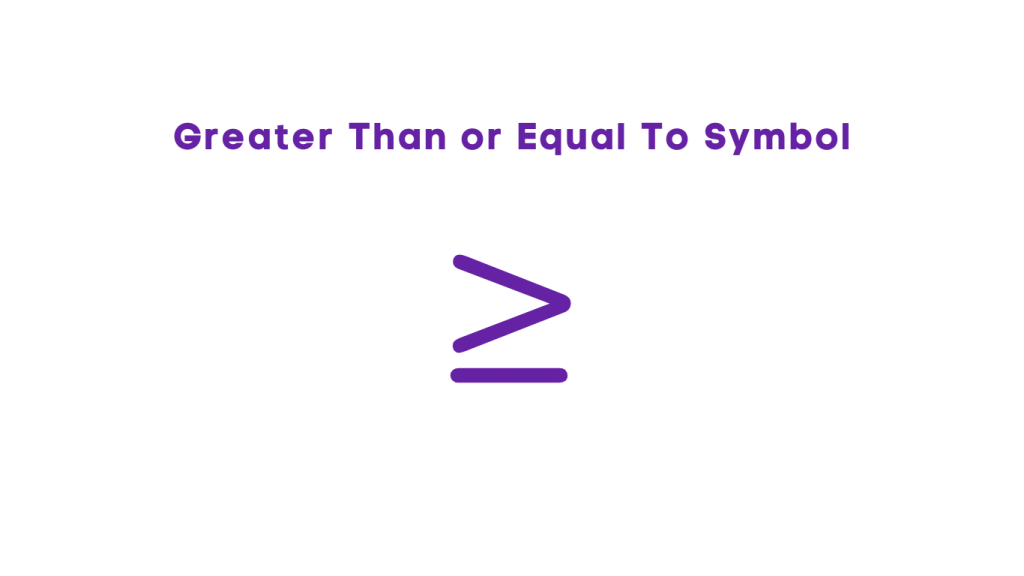Greater Than or Equal To Sign – Meaning and Examples
Table of Contents
Introduction
Greater Than or Equal To Sign
In the realm of mathematics, the concept of “greater than or equal to” plays a crucial role in comparing numbers and understanding their relationships. This concept is essential in various mathematical operations and is often depicted on a number line to visually represent the comparison between numbers.
Analogy of Definition
What Does Greater Than or Equal To Mean?
When we say that one number is “greater than or equal to” another number, it means that the first number is either larger than the second number or equal to it. In other words, it encompasses both the scenarios of being strictly greater than or being equal to the other number.
Greater Than or Equal To Symbol
The greater than or equal to symbol (≥) is a mathematical symbol used to represent a relationship where one quantity is either greater than or equal to another. It consists of the greater than symbol (>) combined with an extra horizontal line, indicating the possibility of equality between the two quantities being compared. represents a relationship where one quantity is either greater than or equal to another. It indicates that the value on the left side of the symbol is either larger or equal to the value on the right side.

Method
Greater Than or Equal To on Number Line
One effective way to understand the concept of “greater than or equal to” is by using a number line. When comparing two numbers, the number line can visually represent the relationship between them. If a number is to the right of another number on the number line, it is greater than or equal to that number. If it is strictly greater, it will be placed further to the right.
We can represent x ≥ 4 in the number line as,

Examples
Example 1: Comparing 5 and 3
5 is greater than 3, so we can say 5 > 3
5 is also equal to 5, so we can say 5 ≥ 3
Example 2: Comparing 8 and 8
8 is equal to 8, so we can say 8 ≥ 8
Example 3: Comparing 10 and 12
10 is less than 12, so we can say 10 < 12
10 is not equal to 12, so we cannot say 10 ≥ 12
Quiz
Tips and Tricks
1. Think of it as “Big or Equal”
Tip: Remember that the greater than or equal to sign (≥) means “big or equal.” It tells us that the number on the left side is either bigger or the same as the number on the right side.
2. Use Visuals
Tip: Draw two smiley faces—one bigger and one smaller—to represent the numbers being compared. Place the greater than or equal to sign next to the bigger smiley face to show that it’s bigger or equal.
3. Practice Counting
Tip: Count objects together and compare their quantities. If you have more or the same number of objects as your friend, you can use the greater than or equal to sign to show it.
4. Everyday Comparisons
Tip: Relate the greater than or equal to sign to everyday situations, like comparing ages, heights, or the number of toys. For example, if you and your friend have the same number of toys, you can use the sign to show that.
Real life application
Story: “The Challenge of Sarah and Mark”
Sarah and Mark, two enthusiastic students, encountered real-life scenarios where the concept of “greater than or equal to” played a significant role in solving problems and making decisions.
Challenge 1: The Budget Dilemma
Sarah and Mark were planning a budget for their upcoming school project. They needed to ensure that the total expenses were less than or equal to the allocated budget. By comparing the expenses to the budget using the “greater than or equal to” concept, they successfully managed their finances and completed the project within the approved budget.
Challenge 2: The Time Management Puzzle
As part of a time management exercise, Sarah and Mark had to complete a series of tasks within a specific timeframe. They used the “greater than or equal to” concept to prioritize tasks and allocate time effectively. By ensuring that each task was completed within the designated time or earlier, they optimized their productivity and achieved their goals.
Challenge 3: The Inventory Management Quest
In a business simulation activity, Sarah and Mark were tasked with managing inventory levels to meet customer demand. By comparing the available stock to the required quantities using the “greater than or equal to” concept, they maintained optimal inventory levels and ensured timely fulfillment of customer orders.
FAQ's
Like? Share it with your friends






